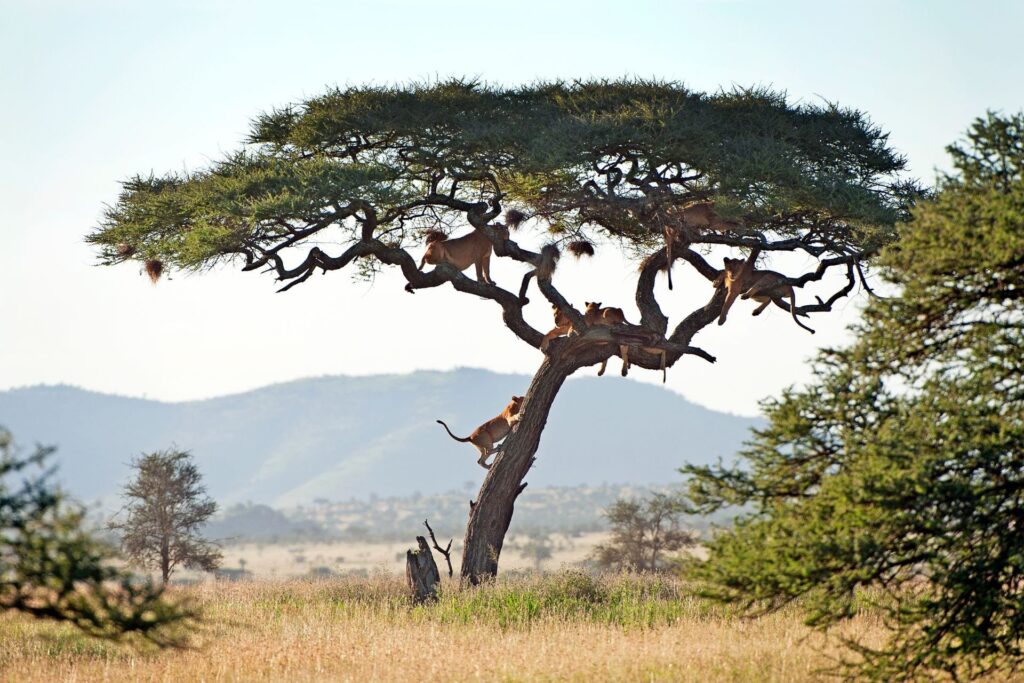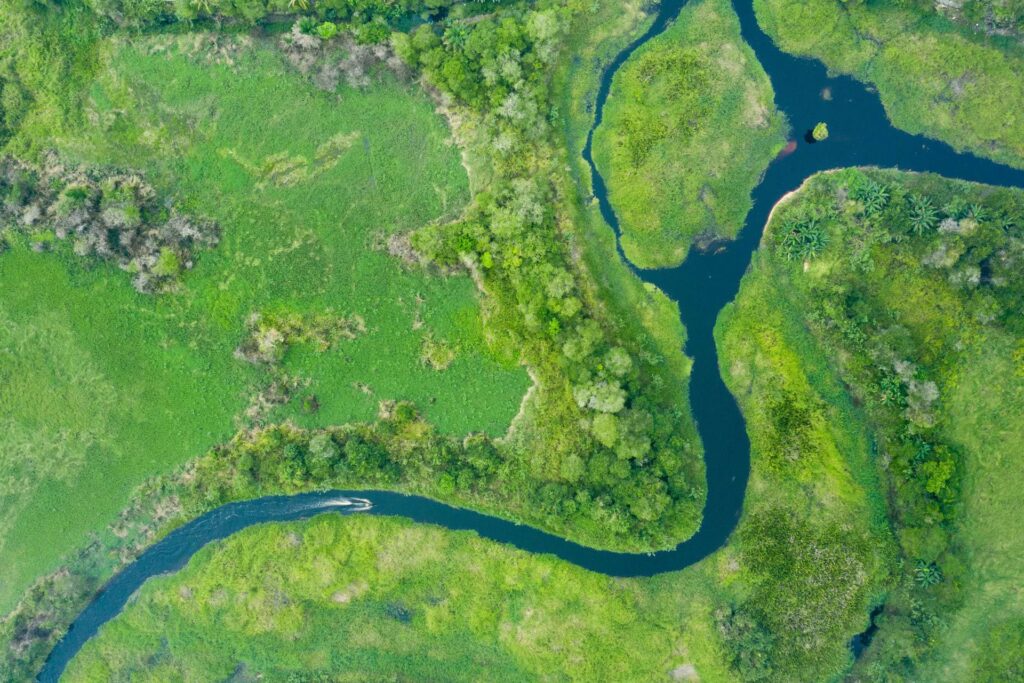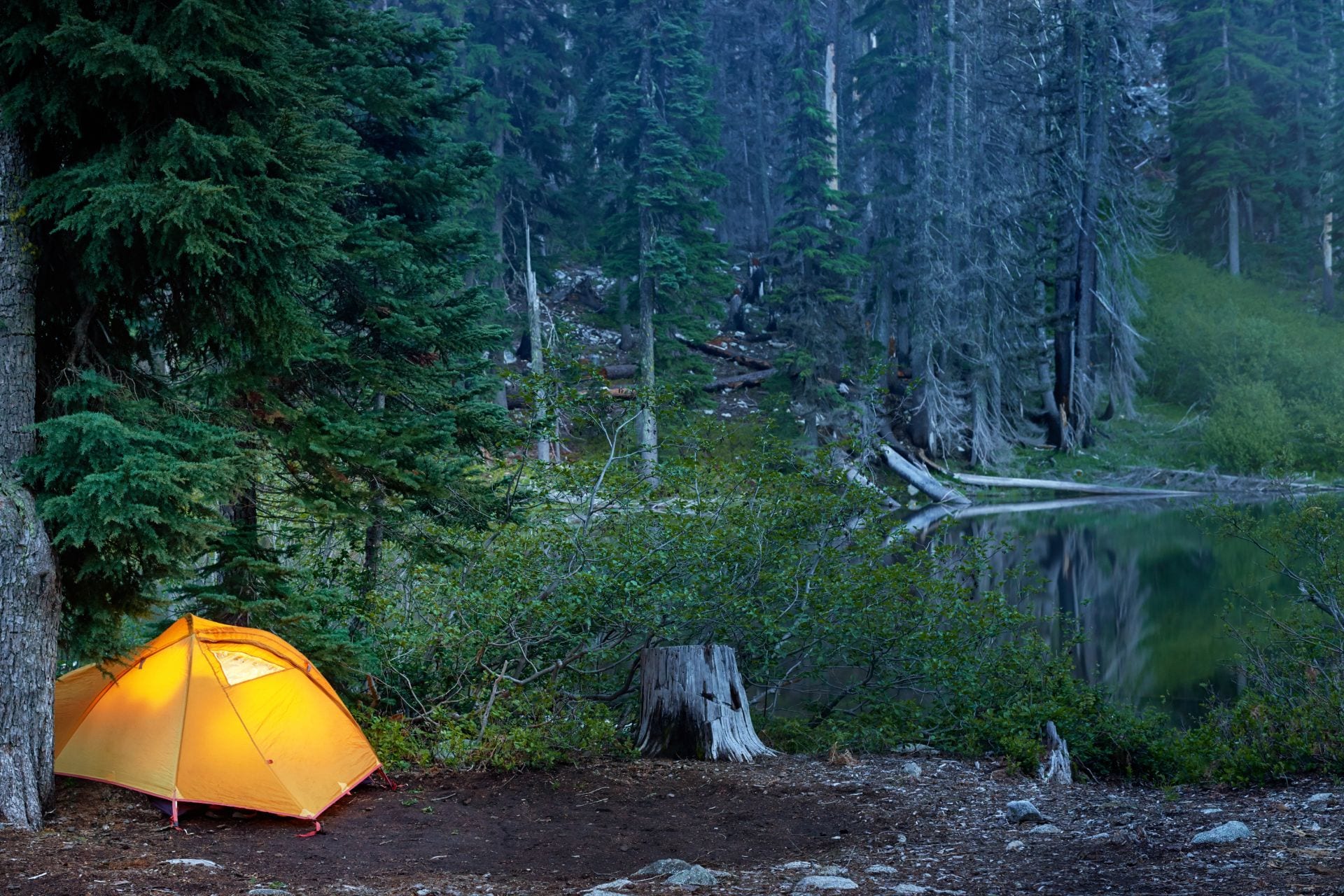Ever been woken up in the night by the sound of hippos at a watering hole? Or seen the exhilarating (yet slightly terrifying) sight of bear tracks through your camp?
Then you haven’t been camping with wildlife.
There are some incredible places in this world where you can go camping with animals, and it’s an experience like no other.
In this post, we’ll show you eight of the best places around the world where you can camp with wildlife and what you can expect to see.
Why Go Camping with Wildlife?
Camping with wildlife doesn’t necessarily mean wild camping or setting up a tent in a forest. What we’re talking about here is camping on a site in a wildlife area or where an abundance of wildlife is found.
So, why go camping with wildlife instead of regular camping?
Unique opportunity for rare encounters
Wildlife camping is a rare and unique opportunity to encounter different species in their natural environment.
From listening to elephants drink from a local watering hole to the cackle of hyenas, you won’t get this experience elsewhere.
Snap some unbelievable photos
If you’re into photography, wildlife camping is also the best chance to snap pictures of some of your favorite animals up close.
Many tour guides know exactly where to go to see certain species, and you’ll get some of the best angles for jaw-dropping photography.
Learn more about the local wildlife
The experts who take you camping with wildlife are also experts. You’ll learn about the different animals, get expert advice on how to leave no trace, and find out more about some of the world’s most diverse habitats.
Support local conservation efforts
If you want to give back, camping with wildlife also has the benefits of volunteer work. Whether you’re camping in a national park or you’re going on a safari, you’ll find volunteer programs and charitable organizations to get involved with.
Tips for Staying Safe When Coming into Contact with Wildlife

It’s easy to forget the dangers of coming into contact with wildlife, and almost all of the animals you’ll see in the wild aren’t friendly. You’ll need to take extra precautions to ensure your safety and the safety of the animals around you.
Fenced campsites aren’t fortresses
If you’re camping in an area known for very dangerous wildlife, you might end up in a fenced campsite. Don’t let this lull you into a false sense of security – animals can still find their way in.
From honey badgers to tigers, many species will be curious about fences, so stay alert and don’t approach any animals at the perimeters.
Don’t leave food lying around
This is an important rule when camping with wildlife. Anything that has a scent (food, drinks, toiletries, garbage, etc.) can and will attract animals. Use a lock-up box or special camping bags to store all of your food and belongings.
If you’re eating a cooked meal around a campfire, make sure to change out of your clothes before bed and leave the ones you were wearing outside of your tent. The last thing you want is a hungry bear sniffing you out.
Don’t feed the wildlife
Animals are attracted to campsites because of the allure of easy food, and it can lead to them becoming less fearful and even reliant on humans.
Monkeys are a huge problem for this – they’ll raid a campsite and steal anything they can get their hands on. The problem is many human foods can be extremely bad for native animals, and this dependence can have disastrous consequences.
To be safe, never leave your food lying around, and don’t be tempted to feed any animal that makes its way into the camp.
Don’t provoke wild animals
If you wake up to find an animal wandering through your camp, don’t run or attempt to scare it off – it almost certainly won’t work. Instead, gently and calmly start making noise so it knows you’re around; this is usually enough to make wild animals leave.
Animals that feel scared or trapped will attack out of fear, so don’t risk injury by making the situation worse.
Don’t leave your tent in big game areas
If you’re going on a safari or camping where there are large animals, don’t leave your tent at night. A lot of large animals are nocturnal grazers, and they might roam through your camp at night looking for grass and water.
Running into a hippo or bear in the dead of night is going to get you in serious trouble, so it’s best to stay safe inside your tent until dawn.
Don’t leave your tent open
Animals don’t understand the boundaries of tents, and if you leave yours even slightly open, they’ll find their way in when searching for food.
At best, you’ll end up with a small rodent or bug infestation. At worst, you’ll come face to face with a bear who has sniffed out your midnight snacks.
To be safe, keep your tent zipped shut and tie the zips together so nothing can sniff its way in during the night.
Don’t spray bug spray at the camp
Mosquitoes are irritating, but bug sprays are poisonous to a range of species. Not only will they kill any bugs that come into contact with them, but they can negatively affect squirrels, bush babies, rodents, and even birds that might be near your camp.
Go for mosquito nets to keep the bugs at bay while protecting the delicate ecosystem you’re visiting.
8 Amazing Locations to Camp with Wildlife
If you can’t wait to camp out in nature and spot some local wildlife, we’ve put together a list of eight of the most amazing places you can camp with wildlife around the world.
Denali National Park, Alaska, USA

Denali National Park is bear country in Alaska. In this park, you’ll find black bears, grizzlies, wolves, and moose roaming around. As well as the larger, more iconic mammals, you’ll also spot red squirrels, arctic ground squirrels, foxes, marmots, and a huge range of impressive birds.
There are six campsites to choose from along Denali’s Park Road:
- Riley Creek Campground
- Savage River Campground
- Sanctuary Campground
- Teklanika Campground
- Igloo Campground
- Wonder Lake Campground
Only one campsite is open year-round, but you can go camping at any time of the year. However, if you’re hoping to spot some bears, spring and summer are the best times to visit.
Kruger National Park, South Africa
Kruger National Park is the perfect place to go on a safari. In the park, you’ll see savannah elephants, lions, cheetahs, leopards, rhinos, buffalo, zebras, and giraffes. If you’re lucky, you might also spot black-backed jackals, African painted dogs, and spotted hyenas roaming at night.
Kruger Park is one of the most affordable campsites in the park, which has options for campsites with and without power points.
The campsites have communal ablution blocks, kitchen facilities, and BBQ areas. At Balule Rest Camp, you get to stay in huts rather than tents, and two hyenas are known for circling the perimeter fence at night.
Since the campsites are very basic with no electricity, the night sky is unbelievable, and you’ll feel much closer to nature.
Yellowstone National Park, Wyoming, USA
No wildlife camping list is complete without a mention of Yellowstone National Park. This park is home to the largest concentration of mammals in the lower 48 states and has a huge diversity of small animals, too.
Yellowstone is most known for its large predators, including black bears, grizzly bears, coyotes, lynxes, mountain lions, and wolves. But you might also spot moose, elk, bison, deer, and bighorn sheep.
There are twelve campgrounds in Yellowstone with 2,000 sites. You’ll need to reserve a spot in advance, and they fill up incredibly quickly between October and April.
“If you want to take an RV to Yellowstone, there are a few Rv-friendly campgrounds to choose from, including Bridge Bay, Canyon, Grant Village, and Madison. But Fishing Bridge RV Park is the only one with water, sewer, and electrical hook-ups, so this one usually fills up quickest.” – Liz from Camping Guidance
Serengeti National Park, Tanzania

The Serengeti is one of the most well-known ecosystems in the entire world, home to over 35 species of plains animals and more than 350 species of birds. If you’re camping with wildlife here, you’ll see it all, from rhinos and hippos to cheetahs and lions.
There are eight public campsites in the Serengeti:
- Nyani
- Pimbi
- Tumbili
- Dik Dik
- Nguchiro
- Ngiri
- Kuro
- Nyegere
Nyani, Pimbi, and Tumbili are the most popular and fill up incredibly quickly in high season. This is because they’re in the heart of the densest wildlife areas in the park.
The facilities are basic in the campsites, but all of them have toilets and cold showers, which is all you really need. At night, you’ll hear the cries of hyenas and roars of lions, which is like nothing else.
Make sure to bring a stove, food, drinking water, and a flashlight, and if you find yourself wanting the toilet at night, it’s not recommended to leave your tent!
Banff National Park, Alberta, Canada
If you’d love to see black bears and grizzly bears roaming the valleys and bald eagles circling overhead, Banff National Park is the place for you. This park is home to 260 species of birds as well as elk, wolves, cougars, and moose.
Banff has thirteen campgrounds with 2,468 sites for campers. Demand peaks between July and September, but you can visit any time of year. The campgrounds work on a first-come-first-serve basis, so book early to get a spot.
- Tunnel Mountain Campground
- Waterfowl Lake Campground
- Mosquito Creek Campground
- Lake Louise Campground
- Protection Mountain Campground
- Johnston Canyon Campground
- Two Jack Lakeside Campground
- Two Jack Main Campground
- Bow Valley Park Campground
You need a camping permit to stay at any of the campgrounds in Banff, which you can get at the campground kiosks. Tunnel Mountain is our favorite campground because it has unbelievable views of the Rockies and is open year-round.
“Banff is very kid-friendly; you’ll find loads of activities within the park if you’re taking little ones. Many of the hiking trails are suitable for kids and there are some great opportunities for kayaking and canoeing on the mountain lakes! When it comes to camping, Tunnel Mountain Campground is the best site for kids since it’s closest to the town for stocking up on supplies.” – Steph from Toddler Trips
Etosha National Park, Namibia

If you’re lucky, you’ll get to see four of the Big 5 in Etosha National Park. Elephants and Lions are pretty common, but leopards are also hiding in the vegetation. Of course, the most iconic reason to visit Etosha is to see the population of black rhinoceros. This is an endangered species, but you’ll get to see healthy herds visiting the local watering holes if you’re lucky.
The plains are also covered with zebra, springbok, black-faced impala, and the rare fleet-footed cheetah.
There are six campsites in Etosha National Park, with a range of accommodation options:
- Okaukuejo Camp
- Halali Camp
- Namutoni Camp
- Dolomite Camp
- Olifantsrus Camp
- Onkoshi Camp
All of the camps are run by Namibian Wildlife Resorts, a government incentive for wildlife conservation. The park has floodlit watering holes near most of the campsites, which allows you to sit and watch the nocturnal animals come for a drink.
You’ll need at least two nights to explore all that Etosha National park has to offer, but four to six nights is the sweet spot for your best chance of seeing all the wildlife.
If you’re a bird lover, the park has one of the most diverse bird habitats in the entire world, and the guides are brilliant and spotting them and telling you all about the different species.
Borneo Rainforest, Malaysia and Indonesia

Sumatra is the only place in the world where you’ll find tigers, rhinos, orangutans, and elephants living together. The Borneo Rainforest is also home to over 15,000 known species of plants and over 400 species of animals. But new species are constantly being discovered, and currently, over 50 species on the islands are new to science.
Most tourists go to Borneo to take an orangutan tour. Along the Sekoyer river, you’ll get to see proboscis monkeys, macaques, crocodiles, and the elusive orangutans themselves.
The jungle tours on offer are world-class, including hikes along the jungle floor, visits to feeding platforms, and night walks through the forests of Borneo.
“Wet season in Indonesia is brutal and can cause major issues when camping in the jungle. Most tours take place between April and October to avoid the wettest seasons, but be wary of setting up camp on low ground – it can flood quickly. There’s also a higher risk of mosquitoes in wetlands, so don’t forget mosquito nets and repellent.” – Eric from The Savvy Campers
Great Barrier Reef, Queensland, Australia
When you think about camping in wildlife, not many people will think about the Great Barrier Reef. But there are some incredible opportunities to camp on several islands in the Reef, most within national parks that form part of the Great Barrier Reef World Heritage Area.
The Great Barrier Reef is made up of around 3,000 individual coral reefs, teeming with biodiversity. If you’re up for snorkeling or scuba diving, you’ll get to see dolphins, turtles, whales, turtles, and sharks off the island coasts.
On some of the islands, during the peak season, you might get lucky enough to see the turtles nesting on the beaches.
But there are some strict rules for camping in the Great Barrier Reef because of the fragile nature of the ecosystem:
- Before visiting, check your boat, clothing, footwear, and gear are free from dirt, soil, plant life, insects, seeds, and any wildlife.
- Clean all of your gear and clothing to ensure there is no soil that could harbor bacteria, viruses, and fungi.
- Avoid any sunscreen that isn’t reef safe.
- Do not touch or disturb any of the wildlife (especially nesting turtles)
- Don’t touch the coral reefs – they’re extremely delicate.
If you want to camp in the Great Barrier Reef, make sure you check the site is open and accepting campers before making plans. The availability changes frequently based on wildlife, weather conditions, and crowding.
Ready to Camp with Wildlife?
We’ve all seen wildlife documentaries and listened to the soothing voice of David Attenborough tell us about all the different species.
But nothing compares to camping in the wilderness and getting to see such rare species up close.
Whether you decide to take a safari camping trip to the Serengeti or want to go looking for grizzlies in the Rockies, you won’t regret camping with wildlife. Just stay safe out there!

